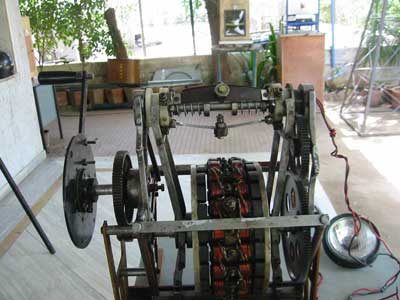What is the name of the solution holder? (main contact person, if multiple)
Mr. Dineshbhai Ashodia
What is the address and preferred way to contact the solution holder?
Block no.401, Subh Aprtment, 4th Floor, Ambaji Kadva Patel Plot -2,Opp Kadavibhai Government School,Rajkot, Phone no.: [REDACTED_PHONE]
Does the solution holder have any institutional affiliation in country?
What is the purpose of the solution? (brief problem & solution description)
The wind operated power generator has two main mechanisms: the flexible stator-rotor system, which delivers power as per varying wind speeds and the governor system. These features of this generator have made it capable of delivering constant output and the capacity to work on low cutting speed, as against other similar devices1 .The AC power generator runs on the principle of mutual inductance. Any prime mover, such as wind power or hydraulic turbine or any source, from which rotary motion is available, can drive it.The highlight of this innovation is the ability to use centrifugal force, generated in the main power shaft with the use of governor, to vary the gap between stator and rotor elements. This allows very low cutting (wind) speeds to start the generator by increasing the air gap at start up. The governor facilitates reduction of this gap at higher speeds. Since the generator output is available from the stator, which is fixed, this does not require brush or slip ring.The shaft rotates and the centrifugal action helps in varying the gap between stator and rotor elements. When the rotor shaft gains momentum and the speed is increased, the centrifugal weights of the governor fly outwards actuating two levers and bring both the pairs of stator and rotor together with minimum air gap.Using commonly available materials, the innovator has built first functional prototype for Rs 7000 and more work is underway to test and standardize the product.Nirma Institute of Technology, Ahmedabad has also tested this machine. It has been submitted by NIF and GIAN West to TePP as a project proposal for funding and development.This product once fully developed will aid introduction of wind operated energy devices in areas with low wind speeds and will provide a green sustainable energy generation solution. Considering the compact size of the generator and wind blades, it could be fitted on terraces and building in urban areas as well as fields in rural regions.The patent has been filed in USA with the pro bono help of KLNG through SRISTI. 1 Following patents have been found to have some commonality with this innovation of windmill operated variable speed generator, viz. variable speed wind power system with improved energy capture via multi-level conversion. (Patent No. US452570) and variable speed wind turbine with reduced fluctuation and a static VAR mode of operation. (Patent No. US799416). In both the cases the mechanism used to control the output of the generator is totally different from that in the present innovation. Similarly, patent US6900998 describes a variable speed power system with improved energy capture via multilevel conversion, which includes a matrix converter using full-bridge, multilevel switch cells, in which semiconductor devices are clamped to a known constant DC voltage of a capacitor. Another system, which is described in http://www.automation.siemens.com/ld/windkraft/ is based on dual-feed slip ring generators, which is widely used.
Please upload a picture of the solution.
Please insert a link to the solution.
Is this solution DIY / open source or IP protected?
IP protected
Will the solution holder be able to train others (including end-users) in using or replicating the solution?
No
What is the unit cost of this Solution along with any additional cost for maintenance and training?
Is this solution a prototype or product?
Product
If this solution is a product, is it available in the market (off the shelf) or advance order has to be given?
What is the Technological Readiness Level (TRL) of this solution?
8
How much has this solution already been diffused? Is there potential feedback from end-users available?
Please upload a link of end-user feedback
Are there any efficiency benchmarks for this solution (eg. how much energy does it save; how much cheaper does it produce energy than current market rates/ current household expenditure / cost per kW h)?
Are there any other potential bottlenecks affecting cross-border or in country diffusion of this solution?


 7Affordable and clean energy
7Affordable and clean energy
Comments
Log in to add a comment or reply.